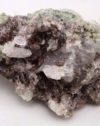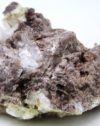$110.00
The name barite is derived from the Greek barytēs, meaning “weight,” an allusion to its high density. It is part of the sulfate family and there is a wide range of colors and crystal habits making it popular among collectors.
Inspiring cerussite has been known since antiquity and was recognized as a mineral species in 1850. Its name stems from cerussa, the Latin word for ceruse, a white-lead pigment.
Locality: Morocco
Out of stock
BARITE
HISTORY, NAME, LOCALITIES: Known since antiquity, barite was described as a mineral species in 1837. Its name is derived from the Greek barytēs, meaning “weight,” an allusion to its high density. Collecting localities are found in Peru, Brazil, China, Germany, Russia, France, Canada, and the United States (Nevada, Colorado, California, Arizona).
MINERALOGY, PROPERTIES, OCCURRENCE: Barite [barium sulfate, BaSO4], pronounced BARE-ite, is the most abundant barium-containing mineral. It crystallizes in the orthorhombic system in clusters of thick-to-thin, tabular crystals with sharp, beveled edges and also in massive and granular forms. It has a Mohs hardness of 4.3-4.6, perfect cleavage in one direction, vitreous luster, and a relatively high specific gravity of 4.3-4.6. Barite crystals are transparent to translucent and have a wide range of colors. Barite occurs in carbonatites, hydrothermal vein and replacement deposits, and as a cementing material in sandstone.
METAPHYSICAL PROPERTIES, LORE, USES: Metaphysical practitioners believe that barite helps to heal the Earth, creates the initiative to pursue dreams without restraint, facilitates independence, and enhances friendship, harmony, and love. Barite is mined extensively as the only source of barium metal and barium compounds. Because of its density, non-toxicity, inertness, and low cost, barite is the “weighting” agent used in oil- and gas-well drilling muds.
COLLECTORS’ INFORMATION: Both as individual crystals and composite specimens, barite is popular among mineral collectors for its range of colors and excellent development of its various crystal habits
CERUSSITE
HISTORY, NAME, LOCALITIES: Cerussite, pronounced suh-RUSS-ite, has been known since antiquity and was recognized as a mineral species in 1850. Its name stems from cerussa, the Latin word for ceruse, a white-lead pigment. Cerussite is abundant and widely distributed. Notable sources are in Germany, Spain, Italy, Morocco, Namibia, Australia, Bolivia, Mexico, and the United States (Arizona, Idaho, Colorado, California, New Mexico).
MINERALOGY, PROPERTIES, OCCURRENCE: Cerussite [lead carbonate, PbCO3] crystallizes in the orthorhombic system as needles, plates, and spikes that are frequently twinned to form distinctive star-like and chevron-like shapes. It is transparent to translucent and usually white or colorless, but impurities can impart yellowish or brownish hues. Cerussite has a Mohs hardness of 3.0-3.5, good cleavage in one direction, an adamantine luster, a conchoidal fracture, and a very high specific gravity of 6.5-6.6. It is a secondary mineral that forms from the oxidation of lead-rich, hydrothermal vein and replacement deposits.
METAPHYSICAL PROPERTIES, LORE, USES: Cerussite was once an important ore of lead and was used extensively the “white lead” pigment in paints and cosmetics. In some localities it is still utilized as a minor ore of lead. To modern metaphysical practitioners, cerussite is a stone of inspiration that instills the willingness to overcome difficulties, aids with our transformation into enlightened beings, and gives hope to those who feel overwhelmed by life.
COLLECTORS’ INFORMATION: Cerussite is collected for the rarity of its well developed, transparent crystals and for the distinctive shapes of its twinned forms.
There are no reviews yet.
 Axinite #10
$40.00
Axinite #10
$40.00 Axinite #8
$45.00
Axinite #8
$45.00 Axinite #10
$40.00
Axinite #10
$40.00 Axinite #8
$45.00
Axinite #8
$45.00
Reviews
Write a review